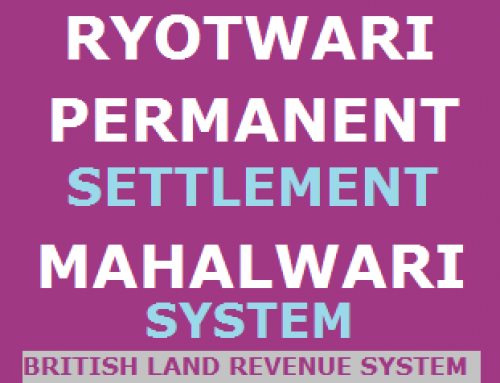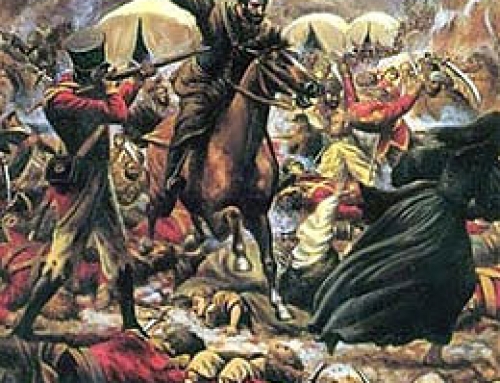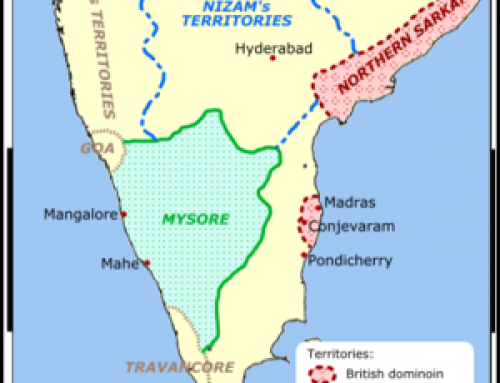The Vijayanagar Empire was established by Harihar and Bukka in 1336 AD. When they set up this principality, Muhammad bin Tughlaq was the Sultan in Delhi.
The Vijayanagar period is divided into four different dynasties- Sangama, Saluva, Tuluva and Aravidu.
It extended from Krishna river to extreme south.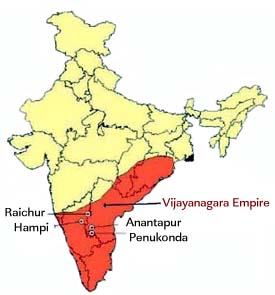
There were many foreign travelers who visited the Vijayanagar empire and left much valuable accounts, these were – Ibn Batuta(Moroccan), Nicolo de Conti(Venetian), Abdur Razzak(Persian), and Domingo Paes(Portuguese).
Sangam Dynasty (1336-1485) – longest reign
Harihar and Bukka were sons of Sangama, feaudatories of Kakatiyas of Warangal. The Hoysala kingdom was conquered and hence, the Vijayanagara empire was extended under Harihara. Bukka, then succeeded his brother and became the master of Raichur doab after dealing with Bahmani Sultan. He destroyed the Madurai Sultans and extended the Empire to the whole of South India.
Sāyaṇa and Madhava were learned commentator on the Vedas, were ministers under Bukka I and Harihara II.
The conflict between Vijayanagara and Bahmani kingdoms was a long lasting one. The bone of contention was the Raichur Doab, between river Krishna and Tungabhadra and Krishna-Godavari delta.
The greatest ruler of Sangama dynasty was Deva Raya II. During his reign, Abdur Razzak, the envoy of Shah Rukh visited the Vijaynagara kingdom.
Saluva Dynasty (1486-1505 AD) – smallest reign
Saluva Narsimhan was the founder of Saluva dynasty. He silenced the rebellions of feaudatories and kept the kingdom intact.
Immadi Narsimha succeeded him. He was a weak ruler and hence the control of state fell into the hands of Narsa Nayaka. Vasco da Gama landed in Calicut during his time in 1498.
Tuluva Dynasty (1505-1570 AD)
The son of Narsa Nayaka, Vira Narsimha was the founder of Tuluva dynasty. He was succeeded by his half brother, Krishnadeva Raya in 1509 AD.
Krishnadeva Raya
At the time of Krishnadevaraya’s accession to the throne, the condition of the empire was unstable, as he had to deal with rebellious subordinates and aggression of the Gajapathis of Orissa and the Muslim kingdoms in the north. Krishna Deva Raya won the Gajapati kingdom in present day Orissa and extended the Vijaya
nagara empire to that region as well. Krishna Deva Raya defeated the Deccan Sultans in the battle of Diwani. He then invaded Raichur Doab(between Tungabhadra and Krishna river, known for its fertile soil) confronting Sultan of Bijapur, Ismail Adil Shah. He also captured Bidar.
He helped the Portuguese to conquer Goa from the Bijapur rulers in 1510 and maintained friendly relations with them. This relationship also helped him obtain high bred Arabian horses and expansion of overseas trade of the empire. Portuguese travelers Domingo Paes and Durate Barbosa visted his court and have left accounts.
Krishna Deva Raya was a contemporary of Babur. So, when the First Battle of Panipat(1526) was fought, Krishnadeva Raya was was the ruler of Vijayanagar in the southern India.
Krishna Deva Raya was a Vaishainaite but respected all religions. He was a devotee of Lord Venkateshwara of Tirupati. Vallabhacharya and Chaitanya Mahaprabhu, the renowned saints of the bhakti movement visited his court. Madhwa saint Vyasathirtha was the Rajaguru of Krishnadevaraya.
He is also known as ‘Andhra Bhoja’, for his patronage of art and literature. Also known as Abhinava Bhoja, he himself was also a scholar, he wrote the Telugu work Amuktamalyada and a Sanskrit play, Jambavati Kalyana. In his court, eight eminent scholars known as ‘Astadiggajas’ were patronized, like – Allasani Peddana (Andhra-kavita-pitamaha) and Nandi Thimmanna. The imperial court had representatives of Sanskrit, Telugu, Kannada and Tamil poets, who made large contributions to their respective literatures.
He built Vijaya Mahal, Hazara Ramaswamy temple and Vithal Swami temple at Vijayanagar
. He also built ‘Rayagopurams’. A new city was built called ‘Nagalapuram’ in memory of his queen Nagaladevi. Also a reservoir across river Tungabhadra called Vallabapuram and a channel called Basavanna were constructed. Krishnadevaraya repaired and restored many south Indian temples, hence, most of the big towers on temples in south India have the name Raya gopuram in his honour.
Acchutadeva suceeded Krishnadeva . The later rulers was Sadashiva Raya but defacto ruler then was Rama Raya.
Battle of Rakshasa- Tangadi-
Rama Raya took active part in Muslim politics. In 1565 AD, all the Sultanates joined a coalition against Vijayanagr except Berar. The Battle of Talikota, also known as Battle of Rakshasa- Tangadi, led to execution of Rama Raya after being taken prisoner. Thereafter, the city of Vijayanagar was destroyed and looted.
Aravidu Dynasty(1570-1650 AD)
Tirumala Raya ruled in name of Sadashiva Raya. They failed to repopulate Vijayanagar and shifted to new capital at Penugonda and then to Chandragiri.
The last ruler of Vijayanagar was Sri Ranga III.
Administration under Vijayanagar Empire:
The kingdom was divided into provinces known as Mandalam, headed by ‘mandaleshwar’. It was further divided into nadu, sthala and grams.
Land revenue was fixed at 1/6th of the produce. Land revenue varied according to nature of cultivated land. There were taxes on various professions.
The Ayagar system: It was an important feature of the village organization in vijayanagar.
- According to this, every village was a separate unit and its affairs were conducted by a team of 12 functionaries who were collectively known as the ‘ayagars’.
- They were granted tax-free lands (manyams) which they were to enjoy in perpectuity for their services. Once granted, these ayagars had a hereditary right over their offieces.
- The ayagars could also sell or mortgage their offices.
For justice, very harsh punishments like mutilation of body, throwing to elephants were delivered.
The army under Vijayanagar Kingdom was well organised and efficient. It consisted of cavalry, infantry, artillary and elephants. The highest grade officers in army were known as ‘Nayaks or Poligars‘. They were awarded land in lieu of their services.
The Nayakara system: Under this system, the king was considered to be the owner of the soil and he distributed the lands to his nayakas.
- Nayakas had to pay a fixed annual financial contribution to the imperial exchequer which, according to the chronicle of Nuniz, was generally half their revenue.
- They were required to maintain a sufficient number of troops for the king and serve them in his war.
- The nayaka enjoyed greater freedom in his province. There was no system of transfer from one district to another.
Society under Vijayanagar empire:
The city of Vijayanagar was a luxurious society with splendid buildings. Slavery was prevalent, as mentioned by Nicolo Conti. Silk and cotton clothes were mainly used for dresses. Vijayanagar markets were noted for dealing in spices, textiles and precious stones.
Religious tolerance was shown towards everyone. Muslims were also employed in the administration. A large number of temples were built during this time. Epics and Puranas were popular among masses.
Position of Women: – Women were employed in royal palaces. Some women scholars like Hannamma, Thirumalamma and Gangadevi, who wrote Madhuravijayam.
- Subordinate condition of women: Devadasi system was flourishing under Vijayanagar Kingdom, dancing girls were attached to the temples. Polygamy was prevalent among royal families. Sati practice was also recounted by traveller accounts.
Architecture under Vijayanagar Empire:
It is generally understood that the very location site of Vijayanagara was inspired by the existence of th
e shrines of Virupaksha and Pampadevi. This is supported by the fact that, the Vijayanagara kings claimed to rule on behalf of the god Virupaksha.
Vijayanagar rulers began the practice of wall inscriptions containing stories of Ramayana and Mahabharata on temples. Vithalswamy and Hazara Rama temple has such inscriptions. 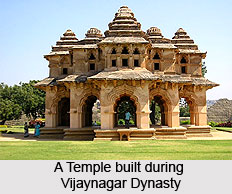
The chief characteristic feature of Vijayanagar Architecture was the construction of tall Raya Gopurams(gateways) and kalyan mandapas(open pavilion) with carved pillars. These mandapas were meant for seating deities on festival occasions. Amman shrines were added to existing temples.
The Varadhraja and Ekamparanatha temple at Kanchipuram are also examples of Vijayanagar style of Architecture.
Foreign Visitors of Vijayanagara Kingdom:
Ibn Bututa (1333-1347 A.D.) — Moroccan traveller, who visited India during the reign of Muhammad-bin-Tughlaq. And came to Vijayanagar during the reign of Harihar I.
Nicolo Conti (1420-1421 A.D.) — Venetian traveller, who gave a comprehensive account of the Hindu kingdom of Vijayanagar.
Abdur Razzaq (1443-1444 A. D.) — Persian traveller, who stayed at the court of the Zamorin at Calicut. He has given a vivid account of the Vijayanagar city, while describing the wealth and luxurious life of the king and the nobles.
Duarte Barbosa (1500-1516 A.D.) — Portuguese traveller, who has given a valuable narrative of the government and the people of the Vijayanagar empire.
Domingos Paes (1520-1522 A.D) — Portuguese traveller, who visited the court of Krishnadeva Raya.
Fernao Nuniz (1534-1537 A.D) — Portuguese merchant, who wrote the history of the empire from its earliest days to the closing years of Acchyutdeva Raya’s reign.
Questions on Vijayanagar Empire
UPSC Civil Services (Mains) 2016 — Krishnadeva Raya, the King of Vijayanagar, was not only an accomplished scholar himself but was also a great patron of learning and literature. Discuss.
UPSC Prelims 2016, the following question was asked.
Regarding the taxation system of Krishna Deva, the ruler of Vijayanagar, consider the following statements :
1. The tax rate on land was fixed depending on the quality of the land.
2. Private owners of workshops paid an industries tax.
Which of the statements given above is/are correct?
A. 1 only
B. 2 only
C. Both 1 and 2
D. Neither 1 nor 2
Recent developments useful for UPSC exams-
Adarsh Smarak Yojana
The Ministry of Culture has launched Adarsh Smarak Yojana and chosen Hampi, Bellary among 25 monuments in the country to be granted ‘Adarsha Smaraks’ tag. The Union government has awarded the tag to monuments which record the highest number of tourists. They would be given special attention to boost international tourism under the Adarsh Smarak Yojana by ASI in form of – wash rooms, drinking water, cafeteria, audio-visual centres, interpretation centres, Wi-Fi connectivity, audio guide facility, land scaping, parking, e-ticketing illumination, Braille signage, facilities for people with disabilities.
- Virupaksha Temple at Pattadkal in Karnataka will be covered in the scheme. Krishnadevaraya, one of the famous kings of the Vijayanagara Empire was a major patron of this temple. The Virupaksha Temple (for Lord Shiva), which existed prior to the Vijayanagar empire and is considered as the ‘Kashi of the South’.
- Hampi is also a world heritage site. The Vittala Temple complex has stone chariot and musical pillars among other monuments are considered as “architectural marvel of human genius” having “outstanding universal values”.


